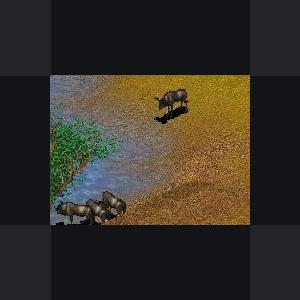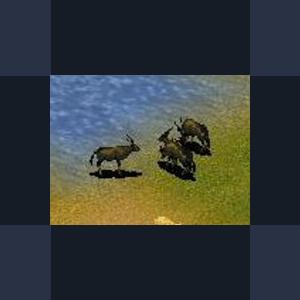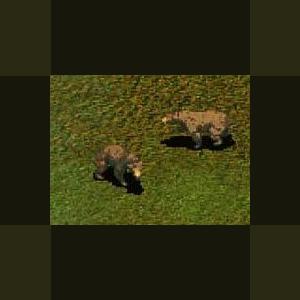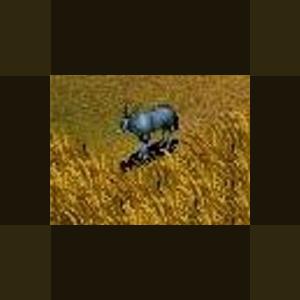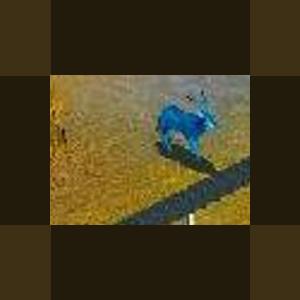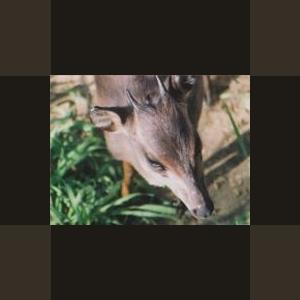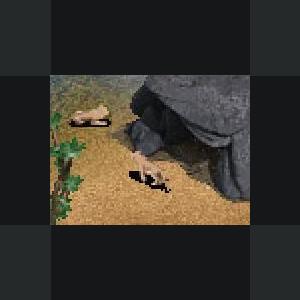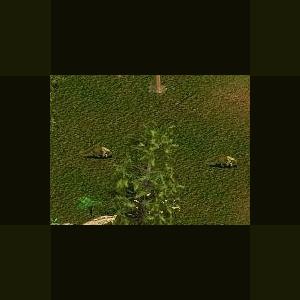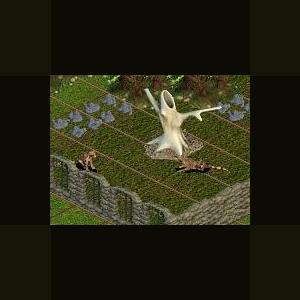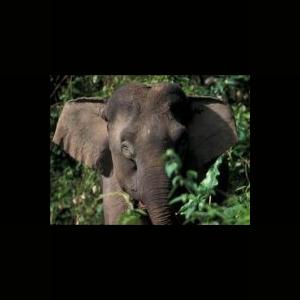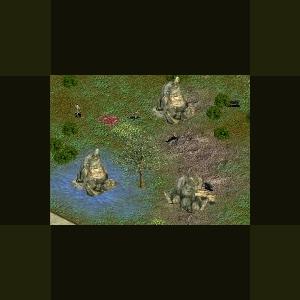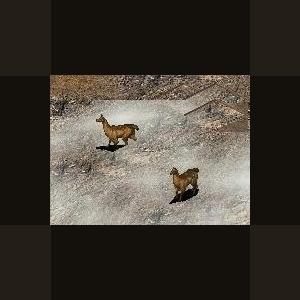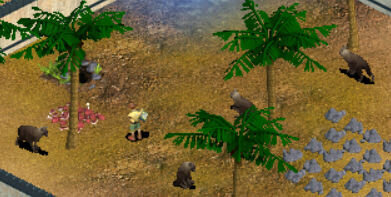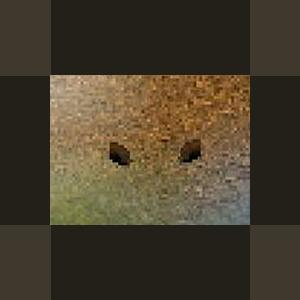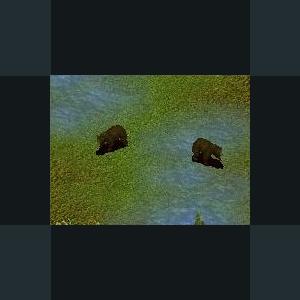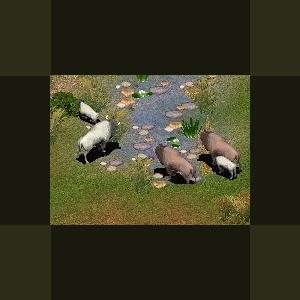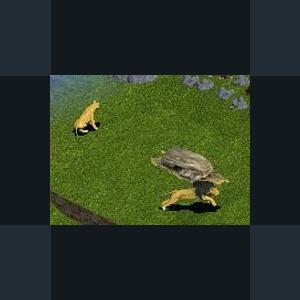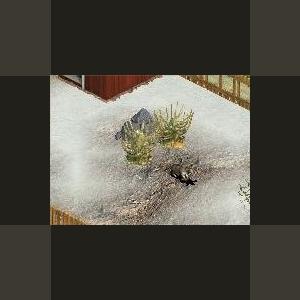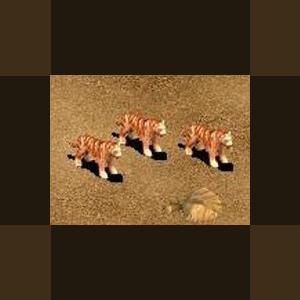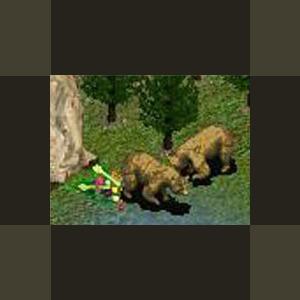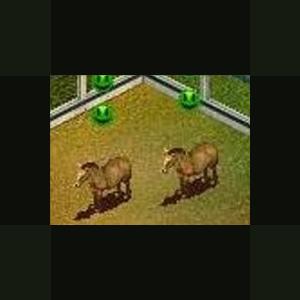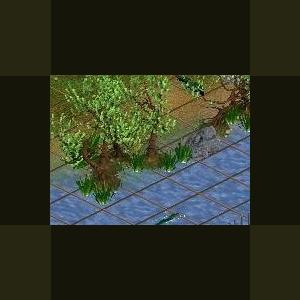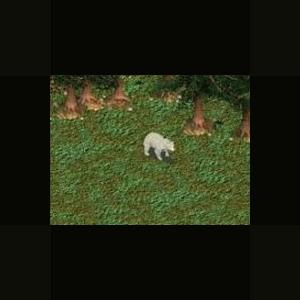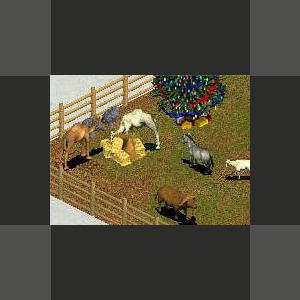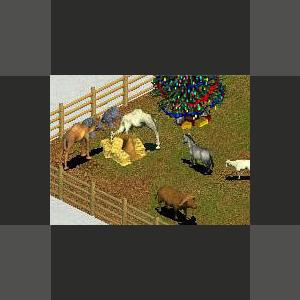279 files
-
Black Wildebeast by G2K
By Guest
Black Wildebeast
Author: G2K
The black wildebeest is dark brown to black in color, males being darker in color than females. Both sexes become lighter in coat color in the summer, and develop shaggier coats in the winter. Like the common wildebeest, Connochaetes taurinus, Connochaetes gnou possesses a bushy beard and mane.
Updated 2010-10-30
Just to save space with less in zip and smaller image.
UPDATED July 25, 2009 by genki to fix the following:
- Fixed LCID error, which can cause some people's games to crash.
- Linked to in-game sounds and removed extra, unneeded sounds.
- Cleaned up .uca and fixed some problems that were coming up on the .uca checker.
Update 8 August 2013 to reupload the updated file because the old file was uploaded in 2010 by mistake.
296 downloads
0 comments
Updated
-
Blesbok by Moondawg
By Guest
The Blesbok, or Blesbuck, (Damaliscus albifrons) is a subspecies of the Bontebok and it is purplish antelope with a distinctive white face and forehead.
They are close relatives of the Bontebok and are only found in South Africa (mostly in protected herds). They were first discovered in the 17th century, but it is not known whether this is because they are a relatively new species or because they have been so elusive.
The Blesbok, or Blesbuck, (Damaliscus dorcas phillpsi) is related to the Bontebok (Damaliscus dorcas dorcas) and it is purplish antelope with a distinctive white face and forehead. Its white face is the origin of its name, because ‘bles’ is the Afrikaans word for blaze. Although they are close relatives of the Bontebok and they can interbreed creating an animal known as the Bontebles they do not share habitat, the Bontebok being found in large numbers on from as far south as Eastern Cape, the plains of the Free State and the Transvaal Highveld. They are a plains species and dislike wooded areas. The blesbuck is indigenous to South Africa and are found in large numbers in all national parks with open grasslands. They were first discovered in the 17th century, and were found in numbers so numerous that herds that reached from horizon to horizon where documented
The neck and the top of the back of the blesbuck are brown. Lower down on the flanks and buttocks, the coloring becomes darker. The belly, the inside of the buttocks and the area up to the base of the tail are white. Blesbucks can be easily differentiated from other antelopes because they have a distinct white face and forehead. The legs are brown with a white patch behind the top part of the front legs. Lower legs whitish. Both sexes have horns, female horns are slightly more slender. The blesbok differs from the bontebok by having less white on the coat and the blaze on the face, which is usually divided, their coats are also a lighter brown than that of the bontebok. The length of their horns averages at around 38cm. Male adult blesboks average around 70kg, females average lower, at around 61kg.
Blesboks can be found in open velds and open plains of South Africa. Preferred habitat is open grasslands with water.
Updated 2010-10-30
Just to save space with less in zip and smaller image.
348 downloads
0 comments
Updated
-
Blond Bear by Ghirin
By Guest
The blond bear is a color phase of the American black bear. This particular color phase is most common in the western portion of North America and is thought to be due to the more open habitat of that region. Brown, black, and cinnamon “black” bears are also found in the same regions as blond bears.
Blond bears have the same habitat needs as regular black bears. It is compatible with black, cinnamon, and glacier phases of the American bear.
Updated 2010-10-30
Just to save space with less in zip and smaller image.
249 downloads
0 comments
Updated
-
Blue Buck Gems by Sundance
By Guest
Bluebuck by Sundance
The Bluebuck was created by sundance, with fixings by Jay.
The early travellers found the blue antelope only in relatively well-watered country, which suggests that, like the roan and sable, it had to drink regularly. Also like the roan andsable, the blue antelope apparently lived in small herds of up to twenty individuals, and it was primarily a grass-eater or grazer that sometimes fed on the same pastures as sheep.
Updated 2010-10-30
Just to save space with less in zip and smaller image.
216 downloads
0 comments
Updated
-
Blue Buck Sable Antelope by Sundance
By Guest
Bluebuck Sable Antelope by Sundance
This guy is a real cutie! works with zt, dd , mm and cc.
The early travelers found the blue antelope only in relatively well-watered country, which suggests that, like the roan and sable, it had to drink regularly. Also like the roan and sable, the blue antelope apparently lived in small herds of up to twenty individuals, and it was primarily a grass-eater or grazer that sometimes fed on the same pastures as sheep.
Updated 2010-10-30
Just to save space with less in zip and smaller image.
157 downloads
0 comments
Updated
-
Blue Duiker by Jordan
By Guest
Body Length: 50-75 cm / 1.6-2.5 ft.
Shoulder Height: 30-40 cm / 12-16 in.
Tail Length: 7-10 cm / 3-4 in.
Weight: 3.8-5.4 kg / 8.4-12 lb.
Females are generally larger than males in this duiker species. The colour of the coat varies with the region from slate grey to grey-brown, with a bluish sheen on the back. The underparts, inner legs, rump, and underside of the tail are whitish. There is a light eye-brow ridge which curves up to the base of the horns, as well as a glandular slit underneath the eye. The horns are strongly ridged and short, growing 2-10 cm / 0.8-4 inches long. The horns are sometimes absent in females, or hidden by the short head crest.
Gestation Period: 7.5 months.
Young per Birth: 1, rarely twins.
Weaning: By 5 months.
Sexual Maturity: Females at 9-12 months, males at 12-18 months.
Life span: 10-12 years.
Kids lie concealed away from the mother for 2-3 months. At this point their coat changes from reddish brown to the grey-blue colour of adults.
The blue duiker is mostly active at night and at dawn and dusk. Bonded pairs patrol their territory, which are 2.5-4 hectares in size, regularly marking them with scent clues from their pedal glands (situated between the hooves), facial glands, and from defecating. Both sexes chase off any intruders, but will remain tolerant of their own young until they reach 18 months of age. The mother and young contact through soft groaning calls, both freezing at the slightest alarm. Males may emit a whistle or a sneezing sound to raise the alarm. Population densities of up to78 per square kilometer have been recorded in Gabon.
Family group: Solitary or in mating pairs.
Diet: Leaves, buds, shoots, grasses, fruit, insects, eggs.
Created by Jordan, Zoo Tek Designer, 2005.
*Inspired by the Zoo Tek Nature Encyclopedia. (www.zoo-tek.com)
Updated 2010-10-30
Just to save space with less in zip and smaller image.
369 downloads
0 comments
Updated
-
Bobcat by Coolperson5
By Guest
The Bobcat (Lynx rufus), occasionally known as the Bay Lynx, is a North American mammal of the cat family, Felidae. With twelve recognized subspecies, it ranges from southern Canada to northern Mexico, including much of the continental United States. The Bobcat is an adaptable predator that inhabits wooded areas, as well as semi-desert, urban edge, and swampland environments. It persists in much of its original range and populations are healthy.
With a gray to brown coat, whiskered face, and black-tufted ears, the Bobcat resembles the other species of the mid-sized Lynx genus. It is smaller than the Canadian Lynx, with whom it shares parts of its range, but about twice as large as the domestic cat. It has distinctive black bars on its forelegs and a black-tipped, stubby tail, from which it derives its name.
Though the Bobcat prefers rabbits and hares, it will hunt anything from insects and small rodents to deer. Prey selection depends on location and habitat, season, and abundance. Like most cats, the Bobcat is territorial and largely solitary, although there is some overlap in home ranges. It uses several methods to mark its territorial boundaries, including claw marks and deposits of urine or feces. The Bobcat breeds from winter into the spring and has a gestation period of about two months.
The Bobcat has been subject to extensive hunting by humans, both for sport and fur, but its population has proven resilient. The elusive predator has featured in Native American mythology and the folklore of European settlers.
Updated 2010-10-30
Just to save space with less in zip and smaller image.
725 downloads
0 comments
Updated
-
Boris The Aardvark by Ape
By Guest
This animal is made in honor of Boris Aardvark. Idea inspired by Arborius's member-animal request!
Updated 2010-10-30
Just to save space with less in zip and smaller image.
122 downloads
0 comments
Updated
-
Bornean Clouded Leopard by Coolperson5
By Guest
The Bornean Clouded Leopard is a recently discovered species originally thought to be a subspecies of the mainland clouded leopard.It lives on Borneo and Sumatra
Updated 2010-10-30
Just to save space with less in zip and smaller image.
529 downloads
0 comments
Updated
-
Bornean Elephant by Jordan
By Guest
Bornean Elephant
Author: Jordan
http://www.zoo-tek.com/forums/index.php?download=172
Borneo's elephants (Elephas maximus sumatrensis) (Payne et. al. 1985) represent an island population on the perimeter of the distributional range for Asian elephants in Southeast Asia. Their distribution corresponds to the Northeast Borneo Ecoregion of WWF classifications. They are thus likely to be genetically distinct, and may have developed other adaptations from the populations on the mainland and within the central areas of the species' range. Elephants only occur between the Sugut River in north-eastern Sabah and Sembakung River in northern East Kalimantan. Distinct anatomical differences from mainland elephants have prompted some taxonomists to give the Bornean elephant subspecies status (Davies, 1962; Payne et. al. 1985). Despite these differences, often rumoured but never studied, stories persist that Borneo's elephant population may have originated from domesticated elephants released by either the Sultan of Brunei or the Sultan of Sulu, and add a special twist to the mystique of these elephants. The peculiarly restricted distribution on Borneo, the lack of truly fossilised remains and the lack of indigenous names for the species elsewhere on the island, lend credence to this theory but do not confirm it.
Surveys in the early 1990s indicated that Borneo may then have had 1000+ elephants (Dawson, et al., 1996). Recent opportunistic reports indicate that today's population may be higher. There are indications that over the last 15-25 years the elephant population in Sabah has dramatically increased in some localities. Possible reasons are the squeezing and concentration of remaining elephant populations into smaller forest patches due to land use change, and the conversion of primary to secondary forest through commercial harvest of timber, with concomitant alterations of food supply and habitat conditions. However, Borneo's elephants are now coming under very strong extinction pressure. Large-scale conversion of secondary forests to oil palm plantations has begun, and is expected to dramatically increase in the next few years. While elephants do not necessarily require forest to be undisturbed, they do require large tracts of land with plenty of food sources. They readily feed in all kinds of agricultural areas and can cause significant conflicts in areas where their range is fragmented by agriculture. In Sabah, elephants still range over a large connected forest area. Only a few herds are isolated in fragmented, yet still relatively large, forest patches. However, there is a very real danger that the current forest fragments will soon be too small to contain viable populations, and that the large connected forest area will soon be fragmented as planned plantation schemes are carried out. In Sabah, most elephant herds on the border of existing plantation schemes at this time cause little conflict, perhaps indicating that these forest patches are still large enough to supply all the elephants' resource needs. However, the Lower Kinabatangan River, and the Deramakot Forest Reserve much further to the west, are currently developing into major conflict sites. Elephant herd size in this combined area may be up to 500 elephants. The riverine forests of the Lower Kinabatangan, the area's premier remaining elephant habitat, is rapidly being converted to oil palm plantations. The threat of completely disrupting the movements of the resident elephants is very real as the last open habitat "bottle necks" are rapidly being bought up and fenced in by plantations. There are occasional but persistent reports of killings of conflict elephants in the area.
Designed by JordanMK exclusively for Tek Forums.
Updated 2010-10-30
Just to save space with less in zip and smaller image.
442 downloads
0 comments
Updated
-
British Wilderness Pack by G2K
By Guest
This great pack has three animals: the red fox, Black Scottish Cat, and a Scottish Cat, a rock, grass, and gorse.
Scottish Wild Cats are found in the forests and open areas of Scotland and north England.
Red Foxes are found worldwide in a variety of habitats.
Black Scottish wild cats are melanistic forms of scottish wild cats.
Also contains gorse, forest fern and a granite rock.
Updated 2010-10-30
Just to save space with less in zip and smaller image.
24 February 2013 to add the July 2009 update since unfortunately the wrong file was uploaded in 2010 when all files had to be reloaded. The January 2009 update was loaded instead of the July 2009 version.
Updated : Jan 7 2009, to adjust scenery
*UPDATED July 25, 2009 by Genki to fix the following:
- Fixed LCID errors, which can cause some people's games to crash.
- Linked to in-game sounds and removed extra, unneeded sounds.
- Cleaned up .uca and fixed some errors and warnings that were coming up on the .uca checker.
- Foliage (forest fern and gorse) adjusted to make them auto-rotate, and to adjust so that the guests can see over them.
757 downloads
0 comments
Updated
-
Brown Alpaca by Ghirin
By Guest
Brown Alpaca by Ghirin
The alpaca (Lama pacos), a relative of the llama, is a domesticated camelid from the Andes Mountains of South America.
Unlike the llama, the alpaca has been bred for its wool and is much smaller than the llama. The wool of the alpaca is among the finest in the world, bested only by that of the vicuna and certain breeds of goat.
Alpacas come in two wool varieties, suri and huacaya. The wool of the suri alpaca is finer and straighter than that of the huacaya. It falls in locks along the sides of the suri alpaca. The huacaya alpaca is more common than the suri; its wool is crimpy and gives the huacaya a "teddy bear" appearance. The wool of either variety comes in several colors, from white to black.
The peoples of the Andes domesticated the ancestors of the alpaca approximately 5000 years ago and these animals were used as a source of wealth.
*Inspired by the Zoo Tycoon Brains Trust at the Zoo Tek Zoo Tycoon Forums.
References:
http://alpacaplanet....lpacas_FAQ.html
http://www.alpaca.com/thealpaca.cfm
http://www.americasa...outalpacas.html
http://www.llama-llo...id_history.html (excellent picture)
Walker's Mammals of the World, Nowak, 1999.
Updated 2010-10-30
Just to save space with less in zip and smaller image.
153 downloads
0 comments
Updated
-
Brown Hyena by Khaydar
By Khaydar
Adopt a Brown Hyena (Hyaena brunnea) for your zoos.
Animal guide:
Minimum happiness needed for chance of breeding: 90.
Liked foliage:
Savannah foliage, desert foliage
Liked rock:
Savannah rocks, desert rocks, small, medium, large rocks
Animal can jump.
Number of animals allowed per exhibit: 2-8 with 20 squares each.
A suitable exhibit for 2 of this animal has 40 squares containing terrain of:
18 Sand, 8 Savannah Grass, 4 Dirt, 8 Brown Stone, 2 Fresh Water
using 2 grid squares filled with 4 Palm Tree most liked plant
and using 16 Small Rock - Small most liked rock.
Of the 40 squares, 1 nonadjacent squares should be elevated.
Preferred shelter: Large Burrow.
Updated: 19 January 2021 by fern to change the ztd and zip names (to avoid a file name conflict), and to compress the ztd better. None of the files inside the ztd were changed.
213 downloads
- living animal
- khaydars animal
- (and 1 more)
0 comments
Updated
-
Brown Lemming by Ghirin
By Guest
The brown lemming (true lemming. genus Lemmus) is a small, stout-bodied rodent native to the tundra and boreal areas of the northern hemisphere. They are solitary, living in underground burrows and only coming together for reproduction. They prefer flat, meadow-type habitats and eat greestuff such as grass, bark, moss, lichens and roots.
Brown lemmings are active throughout the year, but their fur does not change to white during the winter.
Brown lemmings are prolific rodents and major increases in populations are recorded regularly. These increases in populations may leave to migration of animals in search of suitable habitat.
Created by Ghirin 2003
Updated 2010-10-30
Just to save space with less in zip and smaller image.
349 downloads
0 comments
Updated
-
Brown Phase North American Bear by Ghirin
By Guest
Even though the most common bear of North America is called the black bear, this bear actually has several color phases. One of the phases is a dark brown color, and sometimes this color phase is confused with the larger brown bear. This particular color phase is more common in the western portion of North America and is thought to be due to the more open habitat of that region. Black, cinnamon, and blond "black" bears are also found in the same regions as brown phase bears.
Created by Ghirin 2004
Updated 2010-10-30
Just to save space with less in zip and smaller image.
220 downloads
0 comments
Updated
-
Buffalo and White Buffalo by Genkicoll
By Guest
These buffalo are very happy in the same exhibit, which is more visually interesting than the in-game bison's exhibit. You can now add wallows or a few hills if you like, as well.
Buffalo
The largest mammal on the North American continent, a healthy adult buffalo needs to have little fear of predators. However, a peacefully grazing animal can change without warning into a snorting, pawing, 2,000-pound threat, with a menacingly lowered head and stiffly upraised tail. Buffalo can charge at speeds over 30 mph. Both male and female buffalo have massive heads, which are not only equipped with lethal horns, but are also effective as battering rams.
Buffalo at rest may be seen rolling and wallowing. Wallows created by buffalo are shallow, dust-filled depressions, and were once a common feature of the plains where they roamed in large numbers. Buffalo live near gravel-lined streams amongst the gently rolling hills and plains of Northern America.
White Buffalo
The Legend of the White Buffalo:
"One summer a long time ago, the seven sacred council fires of the Lakota Sioux came together and camped. The sun was strong and the people were starving for there was no game.
Two young men went out to hunt. Along the way, the two men met a beautiful young woman dressed in white who floated as she walked. One man had bad desires for the woman and tried to touch her, but was consumed by a cloud and turned into a pile of bones.
The woman spoke to the second young man and said, "Return to your people and tell them I am coming." This holy woman brought a wrapped bundle to the people. She unwrapped the bundle giving to the people a sacred pipe and teaching them how to use it to pray. "With this holy pipe, you will walk like a living prayer," she said. The holy woman told the Sioux about the value of the buffalo, the women and the children. "You are from Mother Earth," she told the women, "What you are doing is as great as the warriors do."
Before she left, she told the people she would return. As she walked away, she rolled over four times, turning into a white female buffalo calf. It is said after that day the Lakota honored their pipe, and buffalo were plentiful." - from John Lame Deer's telling in 1967
These animals are fully compatible, and are programmed to like Catfish's small stones, Paardjee's green grass, Sundance's prairie foliage (not released yet), and several user-made shelters. These animals do NOT need a shelter, but they won't object to having one, either. Also shown in screenshot are some of Genki's Tall Grasses, which are exhibit-neutral.
UPDATED October 15, 2008 to make compatible with Genki's Night Mare and Day Mare, to fix a small error in the .ucs, and to make the buffalo like exhibit-neutral items.
Updated 2010-10-30
Just to save space with less in zip and smaller image.
673 downloads
Updated
-
Cape Lion by Ghirin
By Guest
The cape lion (Panthera leo melanochaitus) was native to the mountains of the Cape region of South Africa. It was a large lion, second only to the Barbary lion of North Africa. Like the Barbary lion, the Cape lion was also known for it luxurious black mane that extended beyond the shoulders and fringed the belly.
After the arrival of European settlers, the Cape lion was hunted to extinction in the wild, with the last wild lion killed in 1865.
Lions descended from Cape lion may exist in zoos around the world and a South African Zoo is trying to establish a captive population of these lions in South Africa.
References:
The Doomsday Book of Animals. Day, 1981.
http://news.nationalgeographic.com/news/20...6_capelion.html
Updated 2010-10-30
Just to save space with less in zip and smaller image.
451 downloads
0 comments
Updated
-
Caribou by Hersheyqwert
By Guest
Caribou by Hersheyqwert
Recolor of the Reindeer. The animations has been deleted when they "flew" or anything else with the sparkles. They need snow, grey stone, grass, freshwater, and some dirt in their exhibits. They like a stable and some elevation. They like both the sage bush and tundra plants.
Updated 2010-10-30
Just to save space with less in zip and smaller image.
491 downloads
0 comments
Updated
-
Caspian Tiger by Moondawg
By Guest
The Caspian tiger or Persian tiger (Panthera tigris virgata) was the westernmost subspecies of tiger.
Found in Iran, Iraq, Afghanistan, Turkey, Mongolia, Kazakhstan, Caucasus, Tajikistan, Turkmenistan and Uzbekistan until it apparently became extinct in the late 1950s, though there have been several alleged sightings of the tiger.When extant, the Caspian tiger was the third largest of the known subspecies of tigers. The body of this subspecies was quite stocky and elongated with strong legs, large, wide paws, and unusually large claws. The ears were short and small, and gave the appearance of being without hair on the tips. Around the cheeks, the Caspian tiger was generously furred and the rest of its fur was long and thick. The coloration resembled that of the Bengal Tiger. The skin specimen in the British Museum has a yellow-gold color over the back and flanks, while the sides of the body are lighter than the back and the striping also varies from light to dark brown. The chest and abdomen is white with yellow stripes, while the facial area is yellow with brown stripes on the forehead and obvious white patches around the eyes and cheeks. Outer portions of the legs are yellow and the inner areas white. The tail of this subspecies is yellow and has yellowish white stripes. In winter, the hair of the Caspian tiger was very long, and the tiger had a well-developed belly mane and a short nape mane. Male Caspian tigers were very large and weighed 169-240 kg. Females were not as large, weighing 85-135 kg.
Work with the preserved remains of the Caspian tiger has shown that it shares a comparatively recent common history with the Siberian tiger (P. t. altaica), at least when it comes to maternal or mitochondrial lineages. It appears that tigers colonized Central Asia at most 10,000 years ago, and the modern Siberian stock may be the result of a few Caspian tigers subsequently wandering east via North Asia.
Until the 19th century, Caspian tigers still inhabited wide spaces of Western and Central Asia. In the mid-1800s, Caspian tigers were killed 180 km northeast of Atbasar, Kazakhstan and near Barnaul, Russia (Ognev 1935, Mazák 1981). The only reported Caspian tiger from Iraq was killed near Mosul in 1887 (Kock 1990). In 1899, the last Caspian tiger near the Lop Nur basin in Xinjiang, China, was killed (Ognev 1935). Caspian tigers disappeared from the Tarim River basin in Xinjiang, China, by the 1920s. (Nowell & Jackson 1996) In 1922, the last known tiger in the Caucasus region was killed near Tbilisi, Georgia, after killing domestic livestock (Ognev 1935). The last record of the Caspian tiger on the Ili River, their last stronghold in the region of Lake Balkhash, Kazakhstan, dates to 1948. (Nowell & Jackson 1996)
The Russian government had worked heavily to eradicate the Caspian tiger during planning a huge land reclamation program in the beginning of the 20th century. They considered there was no room for the tiger in their plans and so instructed the Russian army to exterminate all tigers found around the area of the Caspian Sea, a project that was carried out very efficiently. Once the extermination of the Caspian tiger was almost complete, the farmers cleared forests and planted crops like rice and cotton. Due to intensive hunting and deforestation, the Caspian tiger retreated first from the lush lowlands to the forested ranges, then to the marshes around some of the larger rivers, and finally, deeper into the mountains, until it almost certainly became extinct. The last stronghold of the Caspian tiger in the former Soviet Union was in the Tigrovaya Balka area, which is situated in Tajikistan in the undercurrent of Vakhsh River between the Piandj and Kafirnighan at the board of Afghanistan. Though the tigers were reported as being found here until the mid-1950s, the reliability of these claims is unknown.
Updated 2010-10-30
Just to save space with less in zip and smaller image.
Nothing new.
527 downloads
0 comments
Updated
-
Cave Bear by Ghirin
By Guest
The cave bear is an extinct species of bear from Europe. It lived during the Pleistocene era and became extinct approximately 10,000 years ago, at the end of the last glacial period. This animal's scientific name, Ursus spelaeus, is derived from the fact that many of the bear's skeletons have been found in caves. These bears seemed to have spent more time in caves, using them for hibernation, raising young, and dying in them.
Cave bears are similar to brown bears, but some notable differences are present. They were larger than current European brown bears (30%), had higher foreheads and were primarily vegetarian.
Mammoths, Sabertooths and Hominids by Agusti and Anton, 2002.
Created by Ghirin 2003
Updated 2010-10-30
Just to save space with less in zip and smaller image.
Nothing new.
376 downloads
0 comments
Updated
-
Champagne Horse by Sundance
By Guest
Champagne Horse by Sundance
A beautiful horse by Sundance. Made with help from Jay. Thank you, Jay!
Updated 2010-10-30
Just to save space with less in zip and smaller image.
Nothing new.
232 downloads
0 comments
Updated
-
Chinese Alligator by Coolperson5
By Guest
The Chinese Alligator is an endangered species of alligator that resides in the Yangtze River in China.
Created by Coolperson5
Updated 2010-10-30
Just to save space with less in zip and smaller image.
Nothing new.
24 July 2013 Updated and with warnings removed by JohnT.
Also noted: This aligator is just one size, the size of the young in game alligator
460 downloads
0 comments
Updated
-
Chinese White Bear by Ghirin
By Guest
Chinese White Bear
Author: Ghirin
The Chinese White Bear is a legendary animal from the Hubei province of China. It is pure white and is said to live in the Shennongjia forests of that region. It might be a white phase population of Asian brown or black bears.
Created by Ghirin 2005
Updated 2010-10-30
Just to save space with less in zip and smaller image.
Nothing new.
Updated by JohnT with corrections and some clean up in deleting unneeded pal files and uca stuff!
New uca date Aug 20 2012
334 downloads
0 comments
Updated
-
Christmas Animals Part 1 by Ghirin
By Guest
Christmas animals part 1
Oxen are large animals valued for their meat, hide, and milk.
They enjoy the company of other Christmas Petting Zoo animals.
Brown Dromedary camels are the typical "camel" color.
They enjoy the company of other Christmas Petting Zoo animals.
Donkeys have been domesticated for approximately 6000 years.
They enjoy the company of other of Christmas Petting Zoo animals.
Updated 2010-10-30
Just to save space with less in zip and smaller image.
Nothing new.
488 downloads
0 comments
Updated
-
Christmas Animals Part 2 by Ghirin
By Guest
Christmas animals part 2
White dromedary camels are one of the color varieties of dromedary camels.
They enjoy the company of other Chritmas Petting Zoo animals.
Sheep are one of the most valuable animals in the Middle East,
providing humans with meat, wool, and milk.
White Sheep enjoy the company of other Christmas Petting Zoo animals.
Updated 2010-10-30
Just to save space with less in zip and smaller image.
Nothing new.
448 downloads
0 comments
Updated

